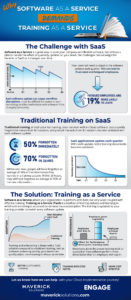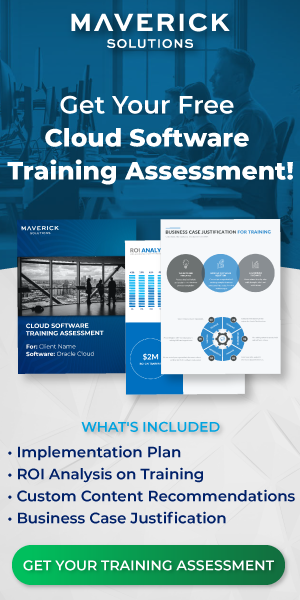Training as a Service, or TaaS, is a relatively new way to train and learn. Traditionally, training and learning involved classrooms and textbooks. But with the advent of Software as a Service, or SaaS, traditional training does not cut it.
Briefly, Training as a Service is training built with Software as a Service in mind. There are many benefits of Training as a Service, but before we jump into some of the benefits of Training as a Service, we will go over Software as a Service.
Software as a Service: Explained
Software as a Service is the method by which applications are delivered to customers. The software is delivered online, in a server provided by the service provider. The service provider updates and maintains the applications for the customer.
Before the advent of Software as a Service, companies would host the hardware at their company site. They would need to manage both software and hardware, and if there were any major bugs, the company would be in charge of resolving them.
The following list details some of the benefits of Software as a Service:
- Companies do not need to use physical space to store the hardware. Server rooms can be converted to grow the company’s headcount.
- The service provider handles any bugs, freeing the company’s IT support team to focus on key business initiatives.
- The service provider updates and maintains the application, keeping the company at the forefront of innovation.
- Employees can access the applications anytime, anywhere, as long as they have an internet connection.
Software as a Service has many benefits. However, Software as a Service is a double-edged sword.
Drawbacks of Software as a Service
Some of the features that make Software as a Service great are the same features that could lead to low ROI and low user adoption for the unprepared company.
In the past, companies would buy an on-premises application, implement it, train their employees to use the software, and use the software for years. Eventually, the company’s decision-makers would decide to update their software, and they would buy the newest version of the software and implement it again. With on-premises software, companies had the control to decide when an update would take place.
For example, let’s say Company A purchased fictional, on-premises software ABC in 2001. Company A purchased software ABC version 1 (because the year is 2001). They implement the software, install the hardware, and hire a training company to come on-site to deliver training to all of the employees. Company A decides to use software ABC version 1 for ten years before purchasing the newest version and updating their software. At this point, software ABC has undergone 9 updates, so Company A is purchasing software ABC version 10. In order to switch the whole company over to software ABC version 10, the company has to save and migrate the data over to the new software, implement the new software, install the hardware as needed, and hire a training company to come on-site to deliver training to all of the employees.

In this example, software ABC had undergone nine updates from the time Company A bought the software in 2001, to the time they purchased the newest version in 2010. Company A did not have any updates automatically implemented until they made the decision to update their software. Company A only had to train their team members twice: when they purchased software ABC version 1 and when they purchased ABC version 10.
With Software as a Service, the application is updated multiple times per year. Take Oracle Cloud software, for example. Oracle delivers a software update quarterly. This means the software changes four times in a year. Somehow, companies with Software as a Service have to keep their team’s trained on the ever-changing software. Traditional training where subject-matter experts come on site to deliver training is not compatible with software that changes every quarter. By the time all of the employees at a company are trained on update 1, the software has already changed.
This is where Training as a Service comes in.
Training as a Service: Explained
Training as a Service is the new way to train. It is built as a solution to the problem Software as a Service poses: how can teams stay trained on software that keeps changing?
Training as a Service is training that is delivered via the web and updated at regular intervals. Like Software as a Service, Training as a Service is maintained and updated by a service provider.
Just like an instructor might switch up their teaching style, Training as a Service can come in various formats to accommodate for different learning styles:
- Documentation
- Step-by-step guides
- Interactive tutorials
- Video tutorials
Unlike an instructor, training with Training as a Service is always available, with an Internet connection.
The following infographic provides more insight into the benefits of Training as a Service:

Benefits of Training as a Service
Many of the benefits of Training as a Service are similar, if not identical, to the benefits of Software as a Service. Let’s dive into some of the benefits of Training as a Service.
The service provider updates and maintains the application.
Training is always updated. This means if the company’s Software as a Service undergoes four updates a year, the training undergoes four updates a year to match the software. Training that is always updated to match the software helps to decrease IT support tickets, keeping IT support staff free to focus on key business initiatives.
Employees can access the applications anytime, anywhere, as long as they have an Internet connection.
Employees can access the training 24/7/365. Why is this important? Say, for example, an employee is on vacation during benefits enrollment time. The employee can’t get to their work computer to review how to enroll for benefits. However, the employee has a smart phone or a personal laptop they can use to log in to their company’s Training as a Service provider, search for the training on Benefits Enrollment, and enroll in benefits.
Or consider the Covid-19 pandemic. Many companies switched, at least temporarily, to remote working. Traditional training where employees all sat in a room with a subject matter expert were not possible in 2020. Training as a Service allows employees to access the training even when they were working from home.
Onboarding is simplified.
Employees can be assigned a learning path to onboard at a company. Before Training as a Service, new employees would need to shadow another employee to learn the various business processes at the company. With Training as a Service, employees can complete their training online, and their managers can view the new employee’s progress through the learning path in a fraction of the time it would have taken to train and onboard.
There are many other benefits to Training as a Service, but one thing is for certain, to get the most out of your Software as a Service, your team needs Training as a Service.
Training as a Service for Oracle Cloud
Oracle Cloud software is one of the Software as a Service applications that require Training as a Service. Oracle Cloud delivers updates to Oracle Cloud applications four times a year. Sometimes, those updates are small, such as a changed button color or a new icon. Others are extensive, such as process changes. Without proper training, the extensive changes would result in countless IT support tickets, frustrated users, and low ROI.
A common question we are asked is if a company can manage and update training internally. Theoretically, a company can manage and update training internally. However, it takes a lot of time and effort. A company would need to have a full internal team dedicated to updating the training. The team would need to work in sprints that run a whole quarter to get the training updated. The training team might need access and funds to contract a subject-matter expert to confirm the training information is accurate. Then the training team would need to deliver the training to the whole company, all while getting ready to update the training again. The workforce, time, subject-matter experts, and other unknown costs can add up, and make more work to develop training internally.
Maverick Solutions has built training specifically for Oracle Cloud software in mind. ENGAGE Learn, Maverick Solution’s Training as a Service offering, is updated quarterly. It is fully customizable, comprehensive, and available 24/7/365. We work with your team to build learning paths, customize training documentation to match your company’s unique business processes, and customize training to look and function like your instance of Oracle Cloud.
ENGAGE Learn helps companies see the following:
- Decrease in IT support tickets.
- Increase in user adoption.
- Increase in user proficiency.
- Increase in ROI on Oracle Cloud investment.
And because training is not always the answer to every user’s software issues, Maverick Solutions also created ENGAGE Live. ENGAGE Live is an in-application support tool that can guide users step-by-step through complex business processes in the live application. Like ENGAGE Learn, ENGAGE Live can do the following:
- Decrease IT support tickets.
- Increase user adoption.
- Increase user proficiency.
- Increase ROI on Oracle Cloud investment.
If you want to learn more about our Training as a Service offering, ENGAGE Learn, speak with one of our training experts today!



